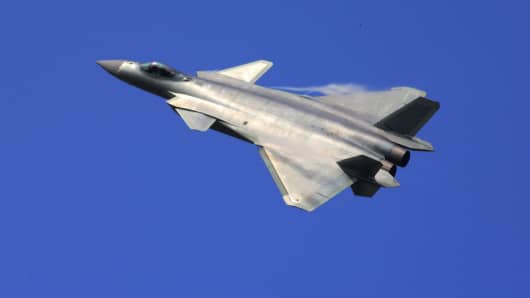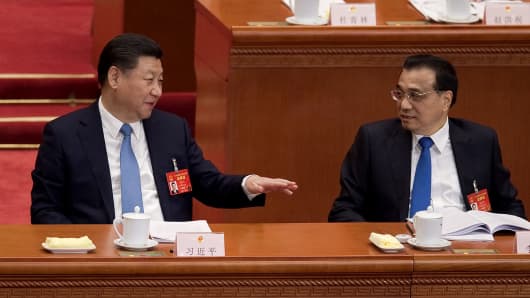By Jeff Daniels

A J-20 stealth fighter of China flies at the 11th China International Aviation and Aerospace Exhibition in Zhuhai, south China's Guangdong Province, Nov. 1, 2016.
China is taking a page from the Pentagon's playbook under the Obama administration: it's partnering with tech companies to develop more cutting-edge weapons.
But China's innovation-focused strategy could elevate the espionage risk to the U.S.
Ironically, this new threat emerges as the Trump administration is expected to slow its outreach to the tech firms.
Over the weekend, Xi Jinping made an address to the country's national legislature where he urged the People's Liberation Army "to speed up" the application of advanced technologies, according to the Chinese military's official web portal.
Jinping sees "integrated military and civilian development" as one of the drivers of science-tech innovation and key to upgrading China's military capabilities.
"If you were to look at reports like Chinese military power over time, it's obvious that China is closing the gap more quickly than, for example, we probably would have estimated five or three years ago," said Anthony Cordesman, a national security expert and Arleigh A. Burke Chair in Strategy at the Center for Strategic and International Studies think tank in Washington, D.C.
The communist nation's military has made major technology strides in the past decade in missile, laser weapon, advanced sensor and stealth aircraft development with the help of Chinese firms in the civilian sector.
Its rapidly developing missile technology is seen as a threat to the West.
"If you were to look at reports like Chinese military power over time, it's obvious that China is closing the gap more quickly than, for example, we probably would have estimated five or three years ago," said Anthony Cordesman, a national security expert and Arleigh A. Burke Chair in Strategy at the Center for Strategic and International Studies think tank in Washington, D.C.
The communist nation's military has made major technology strides in the past decade in missile, laser weapon, advanced sensor and stealth aircraft development with the help of Chinese firms in the civilian sector.
Its rapidly developing missile technology is seen as a threat to the West.
Other major strides have been made in stealth aircraft design and follow state-sponsored cyber and industrial espionage.
"China's overall effort toward civil-military integration will provide great benefits to China's already very aggressive espionage programs," said Richard Fisher, a senior fellow on Asian military affairs at the International Assessment and Strategy Center in Alexandria, Virginia.
According to Fisher, the close ties between military development and the civilian side of China's economy "is one of the highest policies" of the central government in Beijing.
"China's overall effort toward civil-military integration will provide great benefits to China's already very aggressive espionage programs," said Richard Fisher, a senior fellow on Asian military affairs at the International Assessment and Strategy Center in Alexandria, Virginia.
According to Fisher, the close ties between military development and the civilian side of China's economy "is one of the highest policies" of the central government in Beijing.
As an example, Xi Jinping was named earlier this year to chair a new central commission to promote this effort.

Xi Jinping (L) and Li Keqiang attend the third plenary session of the fifth session of the 12th National People's Congress (NPC) at the Great Hall of the People in Beijing on March 12, 2017.

Xi Jinping (L) and Li Keqiang attend the third plenary session of the fifth session of the 12th National People's Congress (NPC) at the Great Hall of the People in Beijing on March 12, 2017.
There are "vast new incentives as well as requirements for the actors in the civilian economy to come up with ways to examine anything innovative that they come up with that can be applied to the military," Fisher said.
A year ago, Su Bin, a Chinese identified as "a businessman in the aviation and aerospace fields" pleaded guilty in the U.S. to participating in a conspiracy to hack into computer networks of major American defense contractors to steal military and export-controlled data.
Court documents show the conspiracy group's targets included the Boeing C-17 military cargo aircraft as well as Lockheed Martin's F-22 and F-35 fighters.

"It's fairly obvious from patterns of industrial espionage that it isn't always the government which has been, for example, seeking data on defense activities in the United States and Europe," said Cordesman.
He added that in some cases it appears "to be people with some kind of private sector or industrial ties."
The espionage organs in China set the priorities and come up with lists of targets.
The espionage organs in China set the priorities and come up with lists of targets.
If a civilian company offers possible linkages to military companies, then the espionage leadership is likely to pursue those leads.
China's major investment in its military comes at a time when President Donald Trump also is calling for "one of the largest increases in national defense spending in American history."
China's major investment in its military comes at a time when President Donald Trump also is calling for "one of the largest increases in national defense spending in American history."
Trump had previously been critical of the Obama administration for "deep cuts in our military, which only invite more aggression from our adversaries."
Given Trump's animosity to Barack Obama's policies, it's probably no surprise that the billionaire president has shied away from endorsing the past administration's so-called Third Offset concept, an innovation push and outreach to Silicon Valley firms.
Given Trump's animosity to Barack Obama's policies, it's probably no surprise that the billionaire president has shied away from endorsing the past administration's so-called Third Offset concept, an innovation push and outreach to Silicon Valley firms.
The initiative was designed under Ashton Carter, the former Defense secretary, to promote cutting-edge tech innovation and give the Pentagon more expertise outside the traditional defense industrial sector.
However, one Pentagon official who was hired in the Obama administration said this week during a South by Southwest panel in Austin, Texas, that the military needs to work and learn from the non-defense side.
"Once we have those bridges built, we're going to have to keep them strong and treat them as a strategic resource," Will Roper, the director of the Pentagon's Strategic Capabilities Office, said during a Wired panel at SXSW on Monday.
However, one Pentagon official who was hired in the Obama administration said this week during a South by Southwest panel in Austin, Texas, that the military needs to work and learn from the non-defense side.
"Once we have those bridges built, we're going to have to keep them strong and treat them as a strategic resource," Will Roper, the director of the Pentagon's Strategic Capabilities Office, said during a Wired panel at SXSW on Monday.
Roper, who has held the post since 2012, indicated that the U.S. military's learning could include something as basic as a better understanding of total logistics from a package delivery company or capabilities in development by major tech firms.
Even so, Trump's Defense Secretary James Mattis — a retired Marine general — appears more focused these days in the nuts and bolts of military readiness rather than an outreach to tech.
To be clear, China's outreach to the civilian side is broader than the Obama administration's Third Offset, which included setting up so-called Defense Innovation Unit Experimental (or DIUx) tech hubs in Silicon Valley, Austin and Boston.
Even so, Trump's Defense Secretary James Mattis — a retired Marine general — appears more focused these days in the nuts and bolts of military readiness rather than an outreach to tech.
To be clear, China's outreach to the civilian side is broader than the Obama administration's Third Offset, which included setting up so-called Defense Innovation Unit Experimental (or DIUx) tech hubs in Silicon Valley, Austin and Boston.
China's military-civilian industry efforts include working in at least eight regions of the country with companies engaged in everything from advanced chip production and information technology to aerospace manufacturing.
One area where DIUx could make a major difference is helping the U.S. military develop technology to better protect against cyber attacks and breaches from adversaries such as China and Russia.
The rapid development of stealth fighter aircraft by China's military coincided with reports back in 2009 of a cyber breach of sensitive national security information from Lockheed's F-35 Joint Strike Fighter program.
The F-35 stealth fighter is the Pentagon's costliest weapons program and includes the acquisition of aircraft for all three of the U.S. military services.
One area where DIUx could make a major difference is helping the U.S. military develop technology to better protect against cyber attacks and breaches from adversaries such as China and Russia.
The rapid development of stealth fighter aircraft by China's military coincided with reports back in 2009 of a cyber breach of sensitive national security information from Lockheed's F-35 Joint Strike Fighter program.
The F-35 stealth fighter is the Pentagon's costliest weapons program and includes the acquisition of aircraft for all three of the U.S. military services.
Foreign allies such as Japan, the U.K., Italy, Israel and others also are participating in buying the aircraft.
"China has already copied major sub-systems for the F-35, especially its advanced optical detection systems, which until recently helped give it a major combat advantage," said Fisher.
"China has already copied major sub-systems for the F-35, especially its advanced optical detection systems, which until recently helped give it a major combat advantage," said Fisher.
"These optical systems appear to now be in production in China."
As a result, Fisher expects the overall advantage the F-35 will give American and allied forces will be "much less" over time than might have been originally anticipated.
Several reports last week indicated that China's new J-20 stealth fighter entered into service, a major milestone for China's military.
As a result, Fisher expects the overall advantage the F-35 will give American and allied forces will be "much less" over time than might have been originally anticipated.
Several reports last week indicated that China's new J-20 stealth fighter entered into service, a major milestone for China's military.
The J-20 resembles the F-22 Raptor air-to-air combat aircraft introduced into the U.S. Air Force in 2005.
Also, China's smaller stealth fighter called the FC-31 Gyrfalcon in development is seen as a knockoff of the F-35.
Also, China's smaller stealth fighter called the FC-31 Gyrfalcon in development is seen as a knockoff of the F-35.
Then again, some observers suggest even the Russians have had their Su-35 Flanker fighter copied by Chinese state-owned firms.
Aucun commentaire:
Enregistrer un commentaire